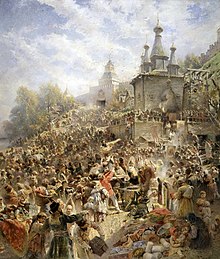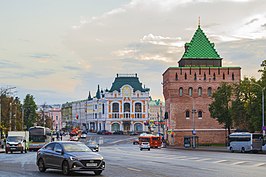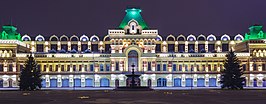
A | B | C | D | E | F | G | H | CH | I | J | K | L | M | N | O | P | Q | R | S | T | U | V | W | X | Y | Z | 0 | 1 | 2 | 3 | 4 | 5 | 6 | 7 | 8 | 9
Nizhny Novgorod
Нижний Новгород | |
|---|---|
Top-down, left-to-right: Dmitrievskaya Tower of the Nizhny Novgorod Kremlin and Minin and Pozharsky Square, Alexander Nevsky Cathedral and Nizhny Novgorod Stadium, Minin and Pozharsky Monument, GAZ, Chkalov Stairs, Nizhny Novgorod Fair. | |
|
| |
| Coordinates: 56°19′37″N 44°00′27″E / 56.32694°N 44.00750°E | |
| Country | Russia |
| Federal subject | Nizhny Novgorod Oblast[1] |
| Founded | 1221[2] |
| City status since | 1221[2] |
| Government | |
| • Body | City Duma[3] |
| • Mayor[5] | Yury Shalabaev[4] |
| Area | |
| • Total | 514.56 km2 (198.67 sq mi) |
| Elevation | 200 m (700 ft) |
| Population | |
| • Estimate (2018)[7] | 1,259,013 |
| • Rank | 5th in 2010 |
| Demonym | Nizhegorodian |
| • Subordinated to | city of oblast significance of Nizhny Novgorod[1] |
| • Capital of | Volga Federal District |
| • Capital of | Nizhny Novgorod Oblast,[1] city of oblast significance of Nizhny Novgorod[1] |
| • Urban okrug | Nizhny Novgorod Urban Okrug[8] |
| • Capital of | Nizhny Novgorod Urban Okrug[8] |
| Time zone | UTC+3 (MSK |
| Postal code(s)[10] | 603000-603999 |
| Dialing code(s) | +7 831[11] |
| OKTMO ID | 22701000001 |
| City Day | 3rd Saturday of August[12] |
| Website | admgor |
 | |
Nizhny Novgorod[a] is the administrative centre of Nizhny Novgorod Oblast and the Volga Federal District in Russia. The city is located at the confluence of the Oka and the Volga rivers in Central Russia, with a population of over 1.2 million residents,[15] up to roughly 1.7 million residents in the urban agglomeration.[16] Nizhny Novgorod is the sixth-largest city in Russia, the second-most populous city on the Volga, as well as the Volga Federal District. It is an important economic, transportation, scientific, educational and cultural centre in Russia and the vast Volga-Vyatka economic region, and is the main centre of river tourism in Russia. In the historic part of the city there are many universities, theatres, museums and churches.
The city was founded on 4 February 1221[17] by Prince George II of Vladimir. In 1612, Kuzma Minin and Prince Dmitry Pozharsky organized an army for the liberation of Moscow and all Russia from the Poles and Lithuanians. In 1817, Nizhny Novgorod became a great trade centre of the Russian Empire. In 1896, at a fair, an All-Russia Exhibition was organized. During the Soviet period, the city turned into an important industrial centre, and was known as Gorky. In particular, the Gorky Automobile Plant was constructed in this period. Around this time, the city was given the nickname "Russian Detroit". Shortly before the dissolution of the Soviet Union the city was renamed Nizhny Novgorod once again. In 1985, the Nizhny Novgorod Metro was opened. In 2016, Vladimir Putin opened the new 70th Anniversary of Victory Plant, which is part of the Almaz-Antey Air and Space Defence Corporation.
The Kremlin – the historic centre of the city – contains the main government agencies of the city and the Volga Federal District. The demonym for a Nizhny Novgorod resident is “нижегородец” (nizhegorodets) for male or “нижегородка” (nizhegorodka) for female, rendered in English as Nizhegorodian. Novgorodian is improper; it refers to a resident of Veliky Novgorod. Nizhny Novgorod was one of the host cities of the 2018 FIFA World Cup.
History
Name
Originally the name was just Novgorod (“Newtown"), but to distinguish it from the other, older and well-known Novgorod (Veliky Novgorod) to the west, the city was commonly called “Novgorod of the Lower lands," or “Lower Newtown.” This land was named “lower” (nizhniy (нижний)), even though it is actually higher in altitude than Veliky Novgorod, because it is situated downstream of other Russian cities such as Moscow, Vladimir and Murom.
Seat of medieval princes
The city traces its origin from a small Russian wooden hillfort that was founded by grand prince Yuri II of Vladimir in 1221 at the confluence of two of the most important rivers in his principality, the Volga and Oka rivers. It marked the eastern extreme of East Slavic settlement until the end of the medieval period, with Russian expansion eastward delayed until the capture of Kazan in 1552.[citation needed]
Its independent existence of the medieval fort was threatened by the continuous Mordvin attacks against it; the major attempt made by forces under Purgaz in April 1229 was repulsed. After the death of Yuri II on 4 March 1238 at the Battle of the Sit River, the Mongols occupied the fortress. Later a major stronghold for border protection, the fortress of Nizhny Novgorod took advantage of a natural moat formed by the two rivers.[citation needed]
Along with Moscow and Tver, Nizhny Novgorod was among several newly founded towns that escaped devastation during the Mongol invasion of Kievan Rus' on account of their insignificance, but grew into great centres in Russian political life during the hegemony of the Golden Horde. With the agreement of the Khan, Nizhny Novgorod was incorporated into the Vladimir-Suzdal Principality in 1264. After 86 years its importance further increased when the seat of the powerful Suzdal Principality was moved there from Gorodets in 1350. Grand Duke Dmitry Konstantinovich (1323–1383) sought to make his capital a rival worthy of Moscow; he built a stone citadel and several churches and was a patron of historians. The earliest extant manuscript of the Primary Chronicle, the Laurentian Codex, was written for him by the local monk Laurentius in 1377.[citation needed]
Fortress city

After the city's incorporation into the Grand Principality of Moscow in 1392, the local princes took the name Shuysky and settled in Moscow, where they were prominent at the court and briefly ascended the throne in the person of Vasily I of Moscow. After being burnt by the powerful Crimean Tatar chief Edigu in 1408, Nizhny Novgorod was restored and regarded by the Muscovites primarily as a great stronghold in their wars against the Tatars of Kazan. The enormous red-brick Kremlin, one of the strongest and earliest preserved citadels in Russia, was built in 1508–1511 under the supervision of Pietro Francesco. The fortress was strong enough to withstand Tatar sieges in 1520 and 1536.[citation needed]
In 1612, the so-called "national militia", gathered by a local merchant, Kuzma Minin, and commanded by Knyaz Dmitry Pozharsky expelled the Polish troops from Moscow, thus putting an end to the “Time of Troubles” and establishing the rule of the Romanov dynasty. The main square in front of the Kremlin is named after Minin and Pozharsky, although it is locally known simply as Minin Square. Minin's remains are buried in the citadel. In commemoration of these events, on 21 October 2005, an exact copy of the Red Square statue of Minin and Pozharsky was placed in front of St John the Baptist Church, which is believed to be the place from where the call to the people had been proclaimed.[citation needed]
In the course of the following century, the city prospered commercially and was chosen by the Stroganovs, the wealthiest merchant family of Russia, as a base for their operations. A particular style of architecture and icon painting, known as the Stroganov School, developed there at the turn of the 17th and 18th centuries.[citation needed]
The historical coat of arms of Nizhny Novgorod in 1781 was a red deer with black horns and hooves on a white field. The modern coat of arms from 2006 is the same, with a ribbon of order of Lenin and gold crown from above.[citation needed]
Commercial centre

In 1817, the Makaryev Fair, one of the liveliest in the world, was transferred to Nizhny Novgorod and started to attract millions of visitors annually. By the mid-19th century, the city was firmly established as the trade capital of the Russian Empire. The world's first radio receiver by engineer Alexander Popov and the world's first hyperboloid tower and lattice shell-coverings by engineer Vladimir Shukhov were demonstrated at the All-Russia industrial and art exhibition in Nizhny Novgorod in 1896. According to official Imperial Russian statistics, the population of Nizhny Novgorod as of 14 January 1913 was 97,000.
The largest industrial enterprise was the Sormovo Iron Works which was connected by the company's own railway to Moskovsky railway station in the Lower City of Nizhny Novgorod. The Kazansky railway station was in the Upper city. Other industries gradually developed, and by the start of the 20th century, the city was also a first-rank industrial hub. Henry Ford helped build a large truck and tractor plant (GAZ) in the late 1920s, sending engineers and mechanics, including future labour leader Walter Reuther.
Soviet era

There were no permanent bridges over the Volga or Oka before the October Revolution in 1917. Temporary bridges were built during the trade fair. The first bridge over the Volga was started by the Moscow–Kazan Railway Company in 1914, but only finished in the Soviet Era when the railway to Kotelnich was opened for service in 1927.
The Marxist activist and Tsarist dissident Maxim Gorky was born in Nizhny Novgorod in 1868 as Alexey Maximovich Peshkov. In his novels he described the dismal life of the city proletariat. When he returned to the Soviet Union in 1932 on the invitation of Joseph Stalin, the city was renamed Gorky. The city bore Gorky's name until 1990. His childhood home is preserved as a museum, known as the Kashirin House, after Alexey's grandfather who owned the place.
During World War II, from 1941 to 1943, Gorky was subjected to air raids and bombardments by Germany. The Germans tried to destroy the city industry because it was a major supplier of military equipment to the front. Of the attacks made in the rear of the Soviet Union, these became the most powerful in the entire duration of the war.[citation needed]
During much of the Soviet era, the city was closed to foreigners to safeguard the security of Soviet military research and production facilities, even though it was a popular stopping point for Soviet tourists traveling up and down the Volga in tourist boats. Unusually for a Soviet city of that size, even street maps were not available for sale until the mid-1970s. In 1970, by the Decree of the Presidium of the Supreme Soviet of the USSR, the city was awarded the Order of Lenin. Mátyás Rákosi, the former Stalinist General Secretary of Hungary's communist party, died in exile there in 1971. On 20 November 1985, in the city, the first section of the metro was launched. The physicist and Nobel laureate Andrei Sakharov was exiled there during 1980–1986 to limit his contacts with foreigners. An end to the “closed” status of the city accompanied the reinstatement of the city's original name in 1990.[18]
Post-Soviet era
The 800th anniversary of Nizhny Novgorod was celebrated on 21 August 2021. It celebrated the history and the great people who came from the city. The climax of the celebration was the city's 800th Anniversary Gala Show. Natalia Vodianova gave a speech and Vladimir Putin was in attendance.[19] The Central Bank of Russia issued commemorative coins to honor the 800th anniversary.[20]
-
Lower-Volga River embankment
-
Kanavino Bridge
Administrative and municipal status
Nizhny Novgorod is the administrative centre (capital) of Volga Federal District and Nizhny Novgorod Oblast.[1] Within the framework of administrative divisions, it is, together with one resort settlement and twelve rural localities, incorporated as the city of oblast significance of Nizhny Novgorod—an administrative unit with the status equal to that of the districts.[1] As a municipal division, the city of oblast significance of Nizhny Novgorod is incorporated as Nizhny Novgorod Urban Okrug.[8] In December 2011, Marat Safin was elected to the Russian Parliament as a member of Vladimir Putin's United Russia Party, representing Nizhny Novgorod.[21]
City layout and divisions

Nizhny Novgorod is divided by the Oka River into two distinct parts. The Upper City (Russian: Нагорная часть, Nagornaya chast, Mountainous part) is located on the hilly eastern (right) bank of the Oka. It includes three of the eight city districts into which the city is administratively divided:
- Nizhegorodsky (the Kremlin, the historical and administrative centre of the city);
- Prioksky
- Sovetsky
The Lower City (Russian: Заречная часть, Zarechnaya chast, Over river part) occupies the low (western) side of the Oka, and includes five city districts:
- Avtozavodsky (built around the Gorky Automobile Plant);
- Kanavinsky (the site of the Nizhny Novgorod Fair and the location of the main train station);
- Leninsky.
- Moskovsky (home of the Sokol Aircraft Plant and its airfield);
- Sormovsky (where Krasnoye Sormovo and the Volga Shipyard are located);
All of today's lower city was annexed by Nizhny Novgorod in 1929–1931.
Demographics
| Year | Pop. | ±% |
|---|---|---|
| 1897 | 90,000 | — |
| 1926 | 221,544 | +146.2% |
| 1939 | 643,689 | +190.5% |
| 1959 | 941,962 | +46.3% |
| 1970 | 1,170,133 | +24.2% |
| 1979 | 1,344,474 | +14.9% |
| 1989 | 1,438,133 | +7.0% |
| 2002 | 1,311,252 | −8.8% |
| 2010 | 1,250,619 | −4.6% |
| 2021 | 1,228,199 | −1.8% |
| Source: Census data | ||
- Population: 1,228,199 (2021 Census);[22] 1,250,619 (2010 Russian census);[23] 1,311,252 (2002 Census);[24] 1,438,133 (1989 Soviet census).[25]
- Births (2009): 12,934
- Deaths (2009): 20,987
Nizhny Novgorod has a population of 1,228,199 within city limits and two million in the urban agglomeration, making it the sixth-largest city in Russia, ranking after Moscow, Saint Petersburg, Novosibirsk, Yekaterinburg and Kazan.[22] Russians make up 94.8% of the city's population. Among the remainder are Tatars, Armenians, Azerbaijanis, Ukrainians, Uzbeks, Jews and others.[26]
Geographу

Time
The area operates in what is referred to in international standards as Moscow Standard Time (MSK), which is 3 hours ahead of UTC, or UTC+3. Daylight saving time is no longer observed.
Climate
In 1834 the first weather station was opened in Nizhny Novgorod. A century later it transformed into Gorky Hydrometeorological service, then since 1978 it is known as the Higher Volga hydrometeorology and natural habitat control department.
The climate in the region is continental, specifically humid continental (Dfb), and it is similar to the climate in Moscow, although colder in winter, which lasts from late November until late March with a permanent snow cover. Average temperatures range from +19 °C (66 °F) in July to −9 °C (16 °F) in January. Average annual temperature is +4.8 °C (40.6 °F), wind speed 2.8 m/s, air humidity 76%. Being far enough away from the Baltic Sea for maritime effects to lower, Nizhny Novgorod has similar winters to Bothnian Bay climates near the Arctic Circle, but instead has very warm summers for its latitude.
Nizhny receives on average 1,775 hours of sunshine a year. The maximum duration of daylight is in June (17 hours 44 minutes), and the minimum in December (6 hours 52 minutes). Overcast is often reported in winter: 75 to 80% of the time the sky is covered in clouds, while it's only 49 to 56% in April through to August. In autumn and winter, the overcast is usually in the mornings, then the sky clears in the afternoon. In spring and summer, on the contrary, it is clear in the mornings, while towards midday clouds cluster ('cumulus cloud'), and disappear towards the evening.
In spring temperatures set above zero around 5 April and stay until the end of October. On average precipitation comes at 653 mm per year, mostly in July and least of all in March. Generally, 180 days out of 365 enjoy some form of precipitation. Snow first comes in October but the blanket of snow insulates the ground at November-end and melts mid-April. As a rule, the air temperature in winter ranges from −10 °C (14 °F) to −20 °C (−4 °F). A storm rarely takes place in winter here (a few dates to mention are 27 November 1940, 30 November 1951, 14 February 1960, and 3 December 1962). In spring there's less precipitation than in other seasons. Spring flies by as snow melts in the second half of March and is normally gone by the end of April. Summer comes at the beginning of June, when the temperature sets around +15. Maximum heat can be observed towards the third decade of July. Average temperatures range from +15 °C (59 °F) to +20 °C (68 °F). A maximum temperature of +38.2 °C (100.8 °F) was recorded during the 2010 Northern Hemisphere summer heat waves. Summer rain is short but intense, with strong wind. In September temperature starts to drop and gets below +10 °C (50 °F) in the mid-20s of the month. It rains often and heavily in autumn, and the sky is overcast.
| Climate data for Nizhny Novgorod (1991–2020, extremes 1835–present) | |||||||||||||
|---|---|---|---|---|---|---|---|---|---|---|---|---|---|
| Month | Jan | Feb | Mar | Apr | May | Jun | Jul | Aug | Sep | Oct | Nov | Dec | Year |
| Record high °C (°F) | 5.7 (42.3) |
7.2 (45.0) |
17.3 (63.1) |
26.3 (79.3) |
32.5 (90.5) |
36.3 (97.3) |
38.2 (100.8) |
38.0 (100.4) |
31.0 (87.8) |
24.2 (75.6) |
15.9 (60.6) |
8.5 (47.3) |
38.2 (100.8) |
| Mean daily maximum °C (°F) | −5.9 (21.4) |
−4.8 (23.4) |
1.5 (34.7) |
11.0 (51.8) |
19.3 (66.7) |
Zdroj:https://en.wikipedia.org?pojem=Nizhny_Novgorod||||||||


















